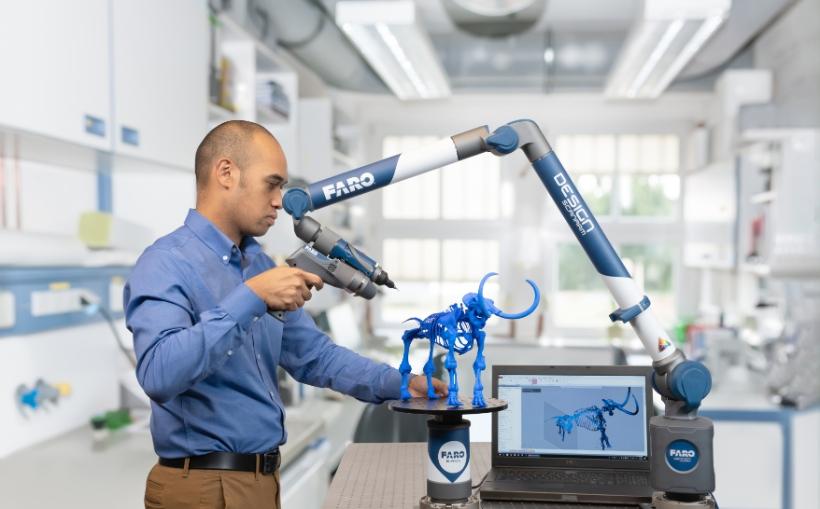- FMA
- The Fabricator
- FABTECH
- Canadian Metalworking
Our Publications
Categories
- Additive Manufacturing
- Aluminum Welding
- Arc Welding
- Assembly and Joining
- Automation and Robotics
- Bending and Forming
- Consumables
- Cutting and Weld Prep
- Electric Vehicles
- En Español
- Finishing
- Hydroforming
- Laser Cutting
- Laser Welding
- Machining
- Manufacturing Software
- Materials Handling
- Metals/Materials
- Oxyfuel Cutting
- Plasma Cutting
- Power Tools
- Punching and Other Holemaking
- Roll Forming
- Safety
- Sawing
- Shearing
- Shop Management
- Testing and Measuring
- Tube and Pipe Fabrication
- Tube and Pipe Production
- Waterjet Cutting
Industry Directory
Webcasts
Podcasts
FAB 40
Advertise
Subscribe
Account Login
Search
From 3D-scanning to 3D-printing to inspecting parts
3D scanning and 3D printing combine to speed and improve the reverse engineering of parts
- By Kip Hanson
- September 22, 2019
- Article
- Additive Manufacturing

Using 3D scanning and 3D printing in combination facilitates the reverse-engineering of parts. Credit: FARO
3D printing has forever altered the world of prototyping and one-off parts production. As proof, anybody with access to CAD software and a 3D printer—which, given the prevalence of cloud-enabled design tools and online service bureaus, is almost everyone—can dream up a new product today and hold a physical version of it in his or her hand tomorrow.
Often, though, the goal isn’t to create anew but to replicate the old, missing, or broken. If you need an old part and there is no CAD model or drawing available, what then? An old-school designer might look to a coordinate measuring machine to handle this reverse-engineering task, followed by days or weeks of CAD reconstruction.
No Print? No Problem
Les Baker, senior applications engineer and scanning arm specialist at FARO Technologies Inc., Lake Mary, Fla., explained that a far more efficient and capable technology exists—one that fits neatly into today’s digital manufacturing landscape and provides a smooth path to 3D-printed parts. It’s called 3D scanning, and, according to Baker, it offers a fast and easy way to build a CAD model of practically anything.
“A scanner is kind of like a camera in that it gathers dimensional information about whatever’s in its field of view,” he said. “What’s different is that a scanner captures a very dense point cloud in three-dimensional space, which can then be used to measure or reverse-engineer a variety of objects quickly and accurately."
The engineering group at Dubai’s Emirates airline, for example, used a FARO ScanArm to reverse-engineer and 3D-print ventilation grills and other cabin components, reducing aircraft weight and spare-parts inventories.
Retired talk show host Jay Leno uses a FARO arm to laser-scan parts for his antique and rare car collection, including a 1922 Revere Model A and a jet-powered EcoJet concept car.
And after visiting Leno’s garage, ventriloquist Jeff Dunham began using the same scan-to-print process to create functional plastic replicas of hand-sculpted clay dummies, eliminating the need for expensive, long-lead-time molds while giving the entertainer greater design flexibility.
Baker noted that several scanning technologies are available. Choosing which one to use depends on the workpiece’s accuracy requirements; its size and complexity; and whether it is shiny, opaque, or transparent.
One of the most capable technologies is called structured light scanning. In simplistic terms, structured light scanning projects blue or white light patterns onto an object—often placed on an automated turntable for 360-degree coverage—and employs a series of cameras to measure and triangulate the reflected light, building a point cloud within seconds.

FARO scanning arm specialist Les Baker (left) explains some of the finer points of 3D scanning to Additive Report Editor Don Nelson at the company’s headquarters in Florida. Credit: FARO
This point cloud can be used to build “a polygon mesh, not unlike a child’s dot-to-dot puzzle,” Baker said. “Special software is needed to construct triangles between the adjacent points or generate more advanced NURBS models and other mathematically driven geometries. Whatever the case, it’s pretty easy to create files for a 3D printer.”
Tugging the Digital Thread
According to FARO, its Cobalt Design 3D scanning solution “offers the broadest 3D data capture capabilities for acquiring complex shapes with detailed textures and color” and is particularly well-suited to reverse engineering.
The company’s director of marketing, Gannon O’Reilly, said FARO customer Emory Motorsports once required “three man-weeks” to create CAD files of vintage Porsche components, then spent months manufacturing the part. After acquiring 3D scanning and 3D printing capabilities, however, the company has reduced the development and manufacturing cycle for such parts to a couple of days.
Mammoth Machine + Design, Huntersville, N.C., is another happy reverse-engineering customer. George Brinzey, co-founder and director of business development, said he and company CEO Ali Bahar use a FARO scanning arm and FORM 2 SLA 3D printer to produce a host of parts and assemblies that would otherwise require long lead times to manufacture.
When a manufacturer of plastic injection molded parts for the food industry was facing months of downtime after a critical machine component caught fire, Mammoth laser-scanned the burned component, 3D-printed a replacement, and had the company up and running the very next day.
Another customer asked Mammoth to design replacement parts for an electrical breaker on its production line, one that routinely failed during monthly maintenance. Here again, Brinzey and Bahar were able to scan the breaker housing and its failed components, print a series of prototypes, use the FARO arm to validate their placement within the assembly, and then machine the approved design from a block of 6061-T6 aluminum.
“Both of these are great examples of our digital production thread,” Brinzey said. “We start by laser-scanning a workpiece or, more often, a complete assembly, then send it over to the 3D printer. If a polymer meets the end-use criteria, we’ll then use the FARO to measure the finished workpiece; otherwise, we’ll machine a metal part on one of our Mazak machining centers or mill-turn lathes and, again, measure it with the FARO. Everything begins and ends with the FARO.”
About the Author

Kip Hanson
About the Publication
- Podcasting
- Podcast:
- The Fabricator Podcast
- Published:
- 04/16/2024
- Running Time:
- 63:29
In this episode of The Fabricator Podcast, Caleb Chamberlain, co-founder and CEO of OSH Cut, discusses his company’s...
- Trending Articles
- Industry Events
16th Annual Safety Conference
- April 30 - May 1, 2024
- Elgin,
Pipe and Tube Conference
- May 21 - 22, 2024
- Omaha, NE
World-Class Roll Forming Workshop
- June 5 - 6, 2024
- Louisville, KY
Advanced Laser Application Workshop
- June 25 - 27, 2024
- Novi, MI



























